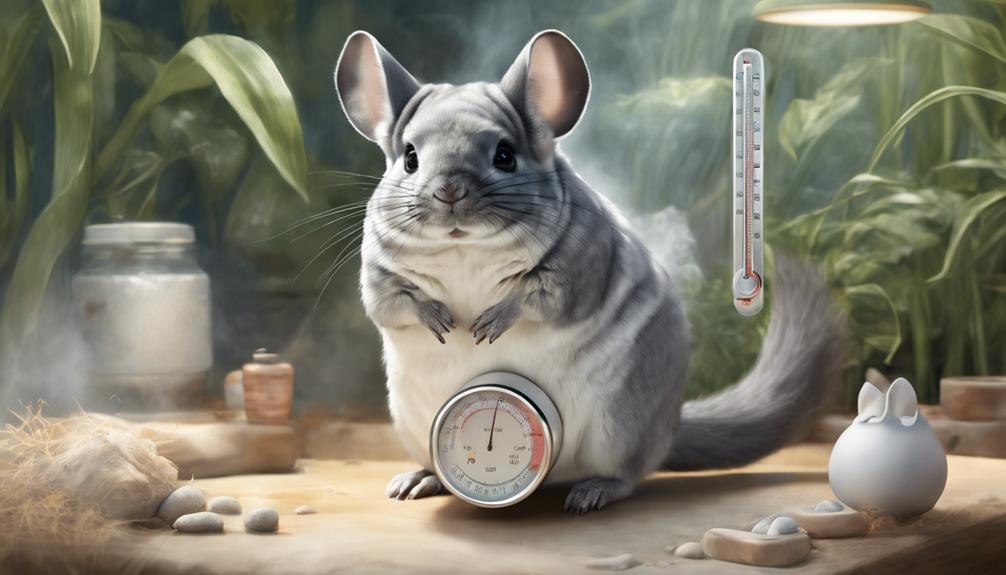How Temperature and Humidity Affect Your Chinchilla's Habitat

Temperature and humidity are crucial for your chinchilla's habitat. Maintaining the right levels ensures their well-being and comfort, impacting their quality of life.
Understanding how to regulate these factors deepens the bond between you and your pet.
Key Takeaways
- Maintaining ideal temperature (60-70°F) and humidity (40-60%) is crucial for chinchilla health.
- Proper temperature and humidity levels prevent health risks and promote healthy fur.
- Regular monitoring, ventilation, and adjustments ensure a comfortable and safe chinchilla habitat.
- Balanced temperature and humidity positively impact behavior, comfort, and overall well-being of chinchillas.
Ideal Temperature Range
In order to safeguard the well-being of chinchillas, maintaining a temperature range between 60 to 70 degrees Fahrenheit is essential for their habitat. Chinchillas are sensitive creatures when it comes to temperature regulation; they thrive in moderate climates. Deviations from this important range can have a notable impact on chinchilla behavior and overall health.
When the temperature exceeds 70 degrees Fahrenheit, chinchillas are prone to heat stress, leading to lethargy and potential health issues. On the other hand, temperatures below 60 degrees Fahrenheit can cause them to enter a state of torpor, where their metabolism slows down, affecting their digestion and overall well-being.
To make sure a comfortable environment for chinchillas, habitat design plays a critical role. Proper ventilation and insulation are key factors in maintaining the ideal temperature range. Additionally, locating the chinchilla's habitat away from direct sunlight or drafts can help in stabilizing the temperature within the recommended range. By understanding the importance of temperature regulation and its impact on chinchilla behavior, owners can create a safe and comfortable living space for their furry companions.
Importance of Proper Humidity Levels
Chinchillas rely on proper humidity levels for their well-being, much like they do with the ideal temperature. Maintaining the right humidity is essential for preventing health issues and ensuring their comfort.
Humidity for Chinchillas
Maintaining ideal humidity levels in the chinchilla habitat is essential for their health and well-being. Humidity regulation plays a critical role in ensuring that chinchillas thrive in their environment. Chinchillas are native to the Andes Mountains, where the climate is cool and dry. So, in captivity, replicating this climate control is important.
Incorrect humidity levels can lead to various health issues for chinchillas, such as respiratory problems and fur matting. By controlling the humidity levels in their habitat, chinchilla owners can create a comfortable and safe living space for their furry companions. Proper humidity not only promotes physical health but also contributes to the overall well-being and happiness of these adorable creatures.
Ideal Levels Needed
A important aspect of ensuring chinchillas' health and well-being is maintaining proper humidity levels in their habitat. Chinchillas are sensitive to humidity, and improper levels can lead to health issues. Temperature regulation and humidity control are important for creating a comfortable environment for these furry creatures. Below is a table outlining the ideal humidity levels needed for chinchillas:
| Humidity Level | Description | Action Needed |
|---|---|---|
| 40% – 60% | Ideal Range | Maintain levels |
| < 40% | Too Dry | Increase humidity |
| > 60% | Too Humid | Decrease humidity |
Health Risks Avoided
Proper humidity levels in a chinchilla habitat are essential for preventing potential health risks and maintaining their overall well-being. Chinchillas rely on the environment to regulate their temperature effectively.
Here are five important aspects to take into account when ensuring the humidity levels are just right:
- Preventing dehydration: Adequate humidity helps chinchillas maintain hydration levels, important for their health.
- Avoiding respiratory issues: Proper humidity reduces the risk of respiratory problems in chinchillas.
- Promoting healthy fur: Balanced humidity levels contribute to the maintenance of a chinchilla's soft and healthy fur.
- Preventing heat stress: Humidity plays a role in temperature regulation strategies, preventing heat stress in chinchillas.
- Enhancing overall well-being: Maintaining the right humidity levels supports chinchillas' overall health and happiness.
Signs of Temperature Stress in Chinchillas
Temperature fluctuations can sometimes cause chinchillas to exhibit signs of stress. When chinchillas are exposed to temperatures outside their comfort range, they may show signs of heat stress. This can manifest through behavior changes such as increased agitation, restlessness, or even aggression. Chinchillas may also display physical symptoms like panting, seeking out cooler areas, or lying flat on the cage floor to dissipate heat.
Monitoring your chinchilla's fur condition is vital in identifying temperature stress. High temperatures can lead to dehydration, which in turn can affect the quality of their fur. If you notice your chinchilla's fur looking dull, dry, or matted, it could be a sign of dehydration due to temperature stress. Additionally, their fur may appear thinner or have bald patches in extreme cases.
Being attentive to these signs and promptly addressing any temperature-related issues can help assure the well-being of your beloved chinchilla.
Tips for Regulating Habitat Temperature

Chinchilla owners can guarantee a comfortable habitat for their furry friends by implementing effective temperature control methods and regularly monitoring humidity levels.
By adjusting the thermostat or using fans strategically, they can create an environment that mimics the chinchilla's natural habitat.
Maintaining ideal temperature and humidity is vital for the well-being and health of these adorable pets.
Temperature Control Methods
With a variety of methods available, one can effectively regulate the habitat temperature for chinchillas. Here are some tips to help maintain the ideal temperature for your furry friends:
- Cooling Strategies
- Using ceramic tiles for them to lie on.
- Providing frozen water bottles wrapped in a towel.
- Installing a fan in the room to circulate air.
- Heating Options
- Placing a safe heat lamp in a corner of the cage.
- Utilizing a heated pad designed for pets.
Humidity Level Monitoring
Monitoring the humidity levels in a chinchilla habitat is essential for maintaining a comfortable and healthy environment for these small mammals.
Humidity control is vital as chinchillas are sensitive to high moisture levels, which can lead to respiratory issues. To regulate humidity, provide good ventilation in the habitat. Use a digital hygrometer to monitor humidity levels regularly.
The ideal humidity range for chinchillas is between 40% to 60%. If the humidity exceeds this range, consider using a dehumidifier or silica gel packets to absorb excess moisture.
Preventing Humidity-Related Health Issues
To maintain a healthy environment for chinchillas, ensuring proper ventilation and using dehumidifiers can help prevent humidity-related health issues. High humidity levels can lead to respiratory problems and mold growth in the chinchilla's habitat. Here are some tips to keep your furry friend safe and comfortable:
- Ventilation is Key: Guarantee good airflow in the chinchilla's living space to prevent humidity buildup.
- Use Dehumidifiers: Invest in a reliable dehumidifier to maintain ideal humidity levels.
- Monitor Humidity Levels: Regularly check and regulate the humidity levels in the chinchilla's habitat.
- Provide Proper Bedding: Choose bedding materials that absorb moisture effectively to prevent dampness.
- Keep Water Sources Away: Place water bottles away from the chinchilla's living area to avoid accidental spills and excess moisture.
Adjusting Habitat for Seasonal Changes

Maintaining a chinchilla's habitat in tune with seasonal changes guarantees their well-being and comfort throughout the year. Making seasonal adjustments ensures that your furry friend thrives despite climate changes, showcasing your dedication to excellent chinchilla care.
| Seasonal Adjustments | Habitat Comfort |
|---|---|
| Increase airflow with a fan during hot months | Guarantees proper ventilation |
| Provide extra bedding in colder seasons | Offers warmth and coziness |
| Adjust lighting based on daylight changes | Maintains natural circadian rhythms |
Monitoring Temperature and Humidity Levels
Ensuring the chinchilla's habitat remains conducive to their needs involves keeping a close eye on temperature and humidity levels. Proper monitoring is essential for creating a comfortable environment for these sensitive creatures.
Here are five key points to take into account:
- Temperature Monitoring: Regularly check the temperature in the chinchilla's habitat to make sure it stays within the recommended range of 60-70°F (15-21°C).
- Humidity Control: Keep humidity levels between 40-70% to prevent respiratory issues and fur problems in chinchillas.
- Use Hygrometer: Invest in a reliable hygrometer to accurately measure humidity levels in the chinchilla's living space.
- Ventilation: Ensure proper ventilation in the habitat to prevent humidity build-up and maintain fresh air circulation.
- Adjustments: Be prepared to make adjustments to the habitat's temperature and humidity levels as needed to provide a comfortable and healthy environment for your chinchilla.
Frequently Asked Questions
Can Chinchillas Tolerate Extreme Temperatures for Short Periods of Time?
Even when extreme, chinchillas can't cope with prolonged exposure to high temperatures. However, brief spells can be managed with cooling pads and proper ventilation. Heat lamps and insulation should be avoided to guarantee their well-being.
How Often Should Temperature and Humidity Levels Be Checked in a Chinchilla's Habitat?
In caring for a chinchilla, it's important to keep a close eye on temperature and humidity levels. Checking frequency and maintenance schedule play an essential role in ensuring a comfortable and healthy habitat for these adorable creatures.
Are There Specific Breeds of Chinchillas That Are More Sensitive to Temperature and Humidity Changes?
Some chinchilla breeds, like the South American variety, show more sensitivity to temperature and humidity changes due to their natural climate adaptations. Monitoring these factors is important to guarantee the well-being of these furry companions.
Can Chinchillas Adapt to Sudden Changes in Temperature and Humidity Levels?
Chinchillas can struggle with sudden temperature fluctuations but may acclimate over time. Humidity spikes can also pose challenges, but chinchillas might adapt gradually. It's important to monitor these changes to guarantee your pet's well-being.
Are There Any Common Household Items That Can Help Regulate Temperature and Humidity in a Chinchilla's Habitat?
During hot spells, chinchilla owners can use fans or frozen water bottles wrapped in towels as DIY solutions for temperature control. Natural remedies like placing a ceramic pot filled with water can help regulate humidity levels.











